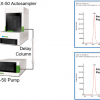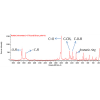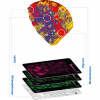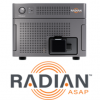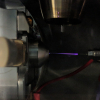Simon Maher,a,b Fred P.M. Jjunju,a Iain S. Young,b Boris Brkica and Stephen Taylora
aDepartment of Electrical Engineering & Electronics, University of Liverpool, Liverpool, L69 3GJ, UK
bInstitute of Integrative Biology, University of Liverpool, Liverpool, L69 7ZB, UK. E-mail: [email protected]
Introduction
Mass spectrometry (MS) is a powerful analytical technique for identifying unknown compounds, quantifying known compounds and exploring molecular structures. Over the past century, since the pioneering work of Thomson,1 MS has become a ubiquitous and indispensable technique with an enormous range of applications. Advances in MS system miniaturisation, portability, versatility and ruggedness have led to mass spectrometers being increasingly deployed for in-the-field analyses.
MS operation requires free movement of gas-phase ions in order to differentiate between them based on their mass-to-charge ratio (m/z). As such, mass analysis, detection and (typically) ionisation are carried out in vacuo. Membrane inlet mass spectrometry (MIMS) is a technique which allows selective and direct introduction of certain analytes of interest into the vacuum chamber of a mass spectrometer through a semi-permeable membrane (via the mechanism of pervaporation). The membrane acts as the interface between the bulk sample matrix and the high vacuum environment of the mass spectrometer. The MIMS technique is simple (no need for sample pre-concentration), sensitive (detection limits are often in the low ppb range) and is able to rapidly analyse multi-component mixtures simultaneously. In this way coupling of a membrane interface to a portable mass spectrometer can allow real-time, in situ analysis with little or no requirement for sample preparation.
MIMS has been used for directly sampling analytes in gaseous, liquid and solid forms. Portable MIMS systems have been utilised for a number of applications such as ocean water analysis, soil analysis and for monitoring of industrial processes. Further information regarding the MIMS technique and applications can be found in review articles such as References 2 and 3.
In this article we examine the use of portable MIMS for in situ oil-in-water (OiW) analysis. Produced water generated through the extraction of oil and gas is the primary waste product from the oil and gas industry. The waste water produced is a combination of formation and injected water containing various concentrations of contaminants. Crude oil is a complex mixture of various organic compounds many of which are toxic. Volatile Organic Compounds (VOCs) from crude oil can have short and long-term adverse effects on human health and the aquatic environment. OiW monitoring is essential both for produced water treatment processing and environmental monitoring. Using a portable MIMS system allows fast and accurate in situ analysis of oil analytes in water.
Instrumentation
Experimental results were obtained using a portable MIMS system with a double filter quadrupole mass spectrometer (QMS) and a probe with a capillary type poly(dimethylsiloxane) (PDMS) membrane supplied by Q-Technologies Ltd, Liverpool, UK.4 A schematic of the set-up is shown in Figure 1.

Two types of North Sea crude oil were investigated: API 36 (type 1) and API 35 (type 2). Mass spectral analysis was used to identify hydrocarbons present in the crude oil; see Figures 2(a) and 2(c).

The membrane was strengthened with a Hastelloy C rod, which was positioned through the membrane. The porous rod was attached to the stainless steel sampling tube with 1/16 in (ca 1.6 mm) outer diameter and approximately 5 cm in length. The tube was connected to the inlet of a mass spectrometer to allow analyte molecules to enter the ion source for ionisation.
Oil-in-water analysis
The MIMS system can be used for measuring crude oil concentrations in water. To achieve the most reliable concentration measurement, a suitable m/z is chosen that has a calibration curve with high linearity. Figure 2 (b) and (d) shows the calibration curves for types 1 and 2 North Sea crude oil for benzene (m/z 78), toluene (m/z 91) and xylene (m/z 105). It should be noted that traces of xylene can also contribute to m/z 91 as well as small traces of other hydrocarbons that naturally occur in crude oil such as cyclohexane and naphthalene at m/z 77 and 78.
In Figure 2 (b) and (d), the m/z values were chosen because they gave slightly higher linearity than other fragment ions. The coefficients of determination for the given BTX (benzene, toluene and xylene) m/z calibration curves (R2) exceed 0.97. The BTX hydrocarbon peak intensities for type 2 crude have significantly lower intensity than type 1 for the same oil concentration. This is due to the nature of type 2 crude because it contains more sand and reservoir solids, which reduce the strength of the output signal [cf. Figure 2 (a) and (c)].
The portable MIMS system has been tested in field trials at the Flotta Oil Terminal (Orkney, Scotland) where crude oil is carried by pipelines from North Sea oil fields and processed for subsequent worldwide distribution.5 At the Flotta Oil Terminal and other facilities, oil is extracted from the produced water until the OiW concentration falls below a government-regulated level and then the resulting water is deemed suitable to be released back into the environment (in this case the North Sea). The Oslo Paris Convention (OSPAR) set a limit for maximum discharge as 30 ppm. Increase in environmental concerns has led to a push for “zero ppm discharge” from the EU Water Framework Directive and other agencies in the region. Even with government regulations, an estimated 2.1 million barrels of oil per day worldwide enter the sea with the discharged water6 which represents a significant environmental and economic loss. Using a portable MIMS system allows low detection limits for OiW and moreover monitoring of individual constituent analytes.
Conclusions and perspectives
Although the portable MIMS system can be used as a stand-alone OiW monitor, there already exist other technologies used on site, such as ultraviolet fluorescence and infrared spectroscopy, that provide fast and accurate measurements. However, using MS techniques provides an additional level of information not offered by other technologies, being able to detect levels of individual constituents contained within oil and the ability to distinguish between different oil types. Recently MIMS has been used to complement existing OiW monitoring technologies by Advanced Sensors (Co. Antrim, UK) an established company in the oil and gas industry.7 They have recently introduced MS to operate alongside their existing OiW monitoring technologies, demonstrating a truly orthogonal sensing platform.
MIMS is a technique which was first demonstrated over 50 years ago although it has not received extensive testing by researchers for in field analysis. With further developments in MS system portability, particularly in terms of both ruggedness and reduced costs, portable MIMS systems are becoming more common place for field work and offer significant advantages for a variety of applications. Using MIMS for analysis of crude oil in water is a simple and effective method for determining oil concentration and monitoring constituent VOCs (BTX). Future work in our group aims to investigate other membrane materials and optimise inlet design to achieve greater sensitivity without sacrificing durability.
References
- J.J. Thomson, Rays of Positive Electricity and their Application to Chemical Analysis. Longmans Green & Co., London (1913).
- R.C. Johnson, R.G. Cooks, T.M. Allen, M.E. Cisper and P.H. Hemberger, “Membrane introduction mass spectrometry: trends and applications”, Mass Spectrom. Rev. 19(1), 1–37 (2000). doi; http://dx.doi.org/10.1002/(SICI)1098-2787(2000)19:13.0.CO;2-Y
- N.G. Davey, E.T. Krogh and C.G. Gill, “Membrane-introduction mass spectrometry (MIMS)”, TrAC Trends Anal. Chem. 30(9), 1477–1485 (2011). doi: http://dx.doi.org/10.1016/j.trac.2011.05.003
- Q-Technologies, http://q-technologies.co.uk
- B. Brkic, N. France and S. Taylor, “Oil-in-water monitoring using membrane inlet mass spectrometry”, Anal. Chem. 83(16), 6230–6236 (2011) doi: http://dx.doi.org/10.1021/ac2008042.
- G. Aanensen, Offshore Europe. Society of Petroleum Engineers, Aberdeen, UK (2007).
- Advanced Sensors, http://www.advancedsensors.co.uk.




